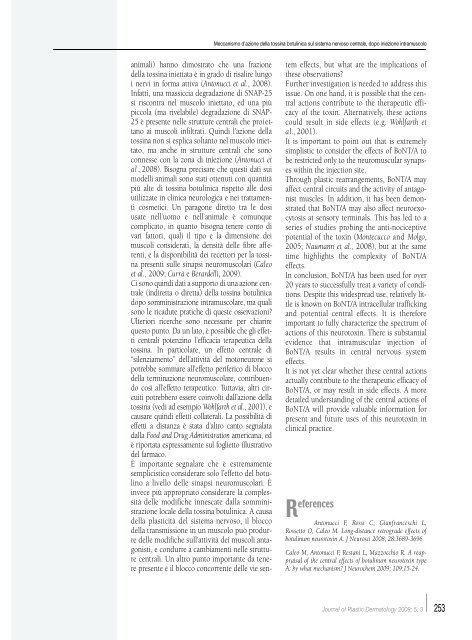Vol. 5, n. 3, September-December 2009 - Salute per tutti
Vol. 5, n. 3, September-December 2009 - Salute per tutti
Vol. 5, n. 3, September-December 2009 - Salute per tutti
You also want an ePaper? Increase the reach of your titles
YUMPU automatically turns print PDFs into web optimized ePapers that Google loves.
Meccanismo d’azione della tossina botulinica sul sistema nervoso centrale, dopo iniezione intramuscolo<br />
animali) hanno dimostrato che una frazione<br />
della tossina iniettata è in grado di risalire lungo<br />
i nervi in forma attiva (Antonucci et al., 2008).<br />
Infatti, una massiccia degradazione di SNAP-25<br />
si riscontra nel muscolo iniettato, ed una più<br />
piccola (ma rivelabile) degradazione di SNAP-<br />
25 è presente nelle strutture centrali che pro i e t-<br />
tano ai muscoli infiltrati. Quindi l’azione della<br />
tossina non si esplica soltanto nel muscolo iniettato,<br />
ma anche in strutture centrali che sono<br />
connesse con la zona di iniezione (Antonucci et<br />
a l ., 2008). Bisogna pre c i s a re che questi dati sui<br />
modelli animali sono stati ottenuti con quantità<br />
più alte di tossina botulinica rispetto alle dosi<br />
utilizzate in clinica neurologica e nei trattamenti<br />
cosmetici. Un paragone diretto tra le dosi<br />
usate nell’uomo e nell’animale è comunque<br />
complicato, in quanto bisogna tenere conto di<br />
vari fattori, quali il tipo e la dimensione dei<br />
muscoli considerati, la densità delle fibre aff e-<br />
renti, e la disponibilità dei recettori <strong>per</strong> la tossina<br />
presenti sulle sinapsi neuromuscolari (C a l e o<br />
et al., <strong>2009</strong>; C u rrà e B e r a rd e l l i, <strong>2009</strong>).<br />
Ci sono quindi dati a supporto di una azione centrale<br />
(indiretta o diretta) della tossina botulinica<br />
dopo somministrazione intramuscolare, ma quali<br />
sono le ricadute pratiche di queste osserv a z i o n i ?<br />
Ulteriori ricerche sono necessarie <strong>per</strong> chiarire<br />
questo punto. Da un lato, è possibile che gli eff e t-<br />
ti centrali potenzino l’efficacia terapeutica della<br />
tossina. In particolare, un effetto centrale di<br />
“silenziamento” dell’attività del motoneurone si<br />
p o t rebbe sommare all’effetto <strong>per</strong>iferico di blocco<br />
della terminazione neuro m u s c o l a re, contribuendo<br />
così all’effetto terapeutico. Tuttavia, altri circuiti<br />
potre b b e ro essere coinvolti dall’azione della<br />
tossina (vedi ad esempio Wohlfarth et al., 2001), e<br />
c a u s a re quindi effetti collaterali. La possibilità di<br />
e ffetti a distanza è stata d’altro canto segnalata<br />
dalla Food and Drug Administration americana, ed<br />
è riportata espressamente sul foglietto illustrativo<br />
del farmaco.<br />
È importante segnalare che è estremamente<br />
semplicistico considerare solo l’effetto del botulino<br />
a livello delle sinapsi neuromuscolari. È<br />
invece più appropriato considerare la complessità<br />
delle modifiche innescate dalla somministrazione<br />
locale della tossina botulinica. A causa<br />
della plasticità del sistema nervoso, il blocco<br />
della transmissione in un muscolo può produrre<br />
delle modifiche sull’attività dei muscoli antagonisti,<br />
e condurre a cambiamenti nelle strutture<br />
centrali. Un altro punto importante da tenere<br />
presente è il blocco concorrente delle vie sentem<br />
effects, but what are the implications of<br />
these observations?<br />
Further investigation is needed to address this<br />
issue. On one hand, it is possible that the central<br />
actions contribute to the therapeutic eff i-<br />
cacy of the toxin. Altern a t i v e l y, these actions<br />
could result in side effects (e.g. Wohlfarth et<br />
a l ., 2001).<br />
It is important to point out that is extremely<br />
simplistic to consider the effects of BoNT/A to<br />
be restricted only to the neuromuscular synapses<br />
within the injection site.<br />
Through plastic rearrangements, BoNT/A may<br />
affect central circuits and the activity of antagonist<br />
muscles. In addition, it has been demonstrated<br />
that BoNT/A may also affect neuroexocytosis<br />
at sensory terminals. This has led to a<br />
series of studies probing the anti-nociceptive<br />
potential of the toxin (Montecucco and Molgo,<br />
2005; Naumann et al., 2008), but at the same<br />
time highlights the complexity of BoNT/A<br />
effects.<br />
In conclusion, BoNT/A has been used for over<br />
20 years to successfully treat a variety of conditions.<br />
Despite this widespread use, relatively little<br />
is known on BoNT/A intracellular trafficking<br />
and potential central effects. It is therefore<br />
important to fully characterize the spectrum of<br />
actions of this neurotoxin. There is substantial<br />
evidence that intramuscular injection of<br />
BoNT/A results in central nervous system<br />
effects.<br />
It is not yet clear whether these central actions<br />
actually contribute to the therapeutic efficacy of<br />
BoNT/A, or may result in side effects. A more<br />
detailed understanding of the central actions of<br />
BoNT/A will provide valuable information for<br />
present and future uses of this neurotoxin in<br />
clinical practice.<br />
R eferences<br />
Antonucci F, Rossi C, Gianfranceschi L,<br />
Rossetto O, Caleo M. Long-distance retrograde effects of<br />
botulinum neurotoxin A. J Neurosci 2008; 28:3689-3696.<br />
Caleo M, Antonucci F, Restani L, Mazzocchio R. A reappraisal<br />
of the central effects of botulinum neurotoxin type<br />
A: by what mechanism? J Neurochem <strong>2009</strong>; 109:15-24.<br />
Journal of Plastic Dermatology <strong>2009</strong>; 5, 3<br />
253

















